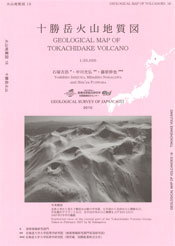Tokachidake Volcano
1: Introduction / 2: Overview of the Tokachidake Volcano Group
3: Eruptive history of the Tokachidake Volcano Group
4: Eruptions in historical times
5: Petrological features of erupted rocks - 6: Sulfur deposit and hot springs
7: Observation of volcanic activities - 8: Points to be noted for mitigation of volcanic disaster
Acknowledgements / References
![]() PREV
PREV ![]() NEXT
NEXT
1: Introduction / 2: Overview of the Tokachidake Volcano Group
1: Introduction
The Tokachidake Volcano Group is a cluster of Quaternary volcanoes in central Hokkaido. Historical eruptions accompanied with pyroclastic materials occurred in 1926, 1962, and 1988-89 since 19th century. During the 1926 eruption, collapse of a scoria cone and resulting mudflow struck the area claiming 146 deaths and missing persons. After the 1988-89 eruption, vigorous fumarolic activities have continued in the central part of the volcano group and seismic activities and crustal deformations have been observed.
Geologic studies of the Tokachidake Volcano Group had been published by by Takahashi ( 1960 ), Katsui et al. ( 1963a ), and NEDO ( 1990 ), after preliminary reports by Notomi ( 1919 ) and Tada & Tsuya ( 1927 ). In addition Ishikawa et al. ( 1971 ) and Katsui et al. ( 1987 ) summarized the eruptive history and recent volcanic activities of the volcano group. Fujiwara et al. ( 2007 ) revised its eruptive history during the last three thousand years. We show this geological map based on our field results and radiometric ages with the summary of the previous studies.
2: Overview of the Tokachidake Volcano Group
2.1 Topography
The Tokachidake Volcano Group is situated at the southwestern end of the Kurile arc, extending from the central part of Hokkaido Island to the Kamchatka Peninsula. The volcano group consists of at least twelve volcanoes with 1,400 to 2,000 m above sea level and their base diameters of 3 to 10 km. These volcanoes are arranged mostly in NE-SW directions extending for 18 km and include from the north, Mt. Oputateshike (Oputateshike Yama), Mt. Biei ( Biei Dake ), Mt. Tairaga ( Tairaga Dake ), Mt. Furano ( Furano Dake ), Mt. Maefurano ( Maefurano Dake ), and Mt. Tairoku ( Tairoku San ). Other volcanoes, perpendicular to the above, in NW-SE direction consisting of Mt. Kamihorokamettoku ( Kamihorokamettoku Yama ), Mt. Okutokachi ( Okutokachi Dake ), and Mt. Shimohorokamettoku ( Shimohorokamettoku Yama ) are also formed.
Volcanic fans are well developed around the foot of the peripheral volcanoes of the volcano group. On the other hand, craters are topographically visible along with fresh surfaces of lava flows on the northwestern slope near the summit of Tokachi Dake, situated at the center of the volcano group. A crater enlarged by erosion and collapsed walls are recognized on the northwestern side of Kamihorokamettoku Yama. Debris avalanche and landslide deposits are widely distributed in the downstream side of the crater and collapsed walls.
2.2 Geology of surrounding area
The basement of the Tokachidake Volcano Group consists of Pliocene volcanic rocks, Late Pliocene Biei Pyroclastic Flow Deposits ( about 1.9 Ma ), and Early Pleistocene Tokachi Pyroclastic Flow Deposits ( 1.1 Ma to 1.2 Ma ). These pyroclastic flow deposits are rhyolitic ignimbrites that are distributed in Asahikawa City, and Biei and Minami-Furano Towns surrounding the volcano group ( Ikeda & Mukoyama, 1983 ). The both pyroclastic flow deposits are inferred to have erupted from the northeastern part of the volcano group on the bases of their distribution, heights of the upper surfaces, and gravity anomalies. The Biei Pyroclastic Flow Deposits are cut by ENE-WSW trending faults and covered by products derived from the Tokachidake Volcano Group. In this geologic map, the fault showing clear displacement is designated as confirmed concealed fault and the rest is shown as inferred concealed fault. Those belong to Quaternary fault movements, while there are no other recognizable faults. Therefore it seems that Quaternary fault movements have been not active in the volcano group.
![]() PREV
PREV ![]() NEXT
NEXT
